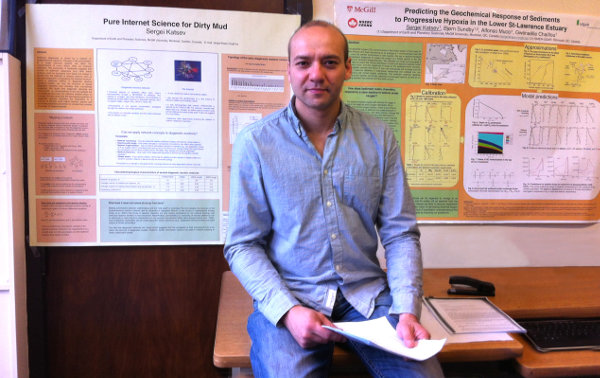
Sergei Katsev
Duluth, MN — Sergei Katsev, associate professor and researcher at UMD’s Large Lakes Observatory, is one of the authors of a paper published this month in Science magazine, among the top scientific journals in the world. His paper is titled, “Sulfate was a trace constituent of Archean seawater.” The lead author is Katsev’s collaborator Sean Crowe from the University of British Columbia.
Katsev and his co-authors have made a connection between the modern Indonesian Lake Matano and the composition of seawater on the planet during the Archaen Eon about 3 billion years ago. Their research implies a significant role for sulfur as an element that may have limited the biological productivity on the Early Earth.
Katsev, a physicist and geochemist, and his colleagues have found clues in the Indonesian Lake Matano to help understand an earth with almost no oxygen. During the Archaen Eon the earth couldn’t support animal or plant life. Only a small number of the microorganisms, cyanobacteria (blue-green algae), produced miniscule amounts of oxygen by photosynthesis. The majority of photosynthetic organisms at that time survived on metabolisms that are exceptionally rare today, such as those that produced iron oxides instead of oxygen.
Lake Matano has properties similar to Early Oceans. Like those ancient oceans, the waters are warm, lacking oxygen, rich in dissolved iron, and habitable to microbial communities similar to those that might have dominated oceans 3 billion years ago.
At almost 600 meters deep, Lake Matano is the seventh deepest lake on the planet. Only the upper, extremely transparent, 100 meters can exchange substances like oxygen with the atmosphere, so the water below 100 meters is permanently anoxic (lacking oxygen). The water is stratified in horizontal layers and vertical mixing below 100 meters is slow. In this anoxic water column, a microbially-catalyzed reaction that converts oxidized sulfur (sulfate) into its reduced form (sulfide) generates a characteristic signature in the distribution of sulfur isotopes, which becomes preserved in the iron-sulfide minerals that form as a result. This signature of isotopic fractionation holds the most significant new evidence about the composition of ancient seawater.
Since 2006 Katsev has been studying Lake Matano, twice through visits to collect samples, and regularly to analyze data collected by other teams. He zeroed in on data about stable sulfur isotopes and created a numerical model to make inferences about the composition of the ancient ocean seawater. The research team’s findings are significant. They have determined that the level of sulfate was two orders of magnitude smaller than presently believed for that time in the Earth history and 10,000 times lower than in the modern ocean.
SEE SCIENCE: http://science.ubc.ca/news/816
Choose appearance:
[ Desktop
| Mobile friendly ]